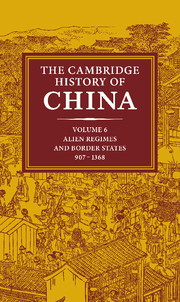Crossref Citations
This Book has been
cited by the following publications. This list is generated based on data provided by Crossref.
Rawski, Evelyn S.
1996.
Presidential Address: Reenvisioning the Qing: The Significance of the Qing Period in Chinese History.
The Journal of Asian Studies,
Vol. 55,
Issue. 4,
p.
829.
Benite, Zvi Ben-Dor
2000.
The New Cambridge History of Islam.
p.
409.
Morgan, David O.
and
Reid, Anthony
2000.
The New Cambridge History of Islam.
Spence, Jonathan D.
2002.
The Cambridge History of China.
p.
120.
Crossley, Pamela Kyle
2002.
The Cambridge History of China.
p.
310.
Peterson, Willard J.
2002.
The Cambridge History of China.
Peterson, Willard J.
2002.
The Cambridge History of China.
p.
1.
Zelin, Madeleine
2002.
The Cambridge History of China.
p.
183.
Dennerline, Jerry
2002.
The Cambridge History of China.
p.
73.
Woodside, Alexander
2002.
The Cambridge History of China.
p.
230.
Elman, Benjamin A.
2002.
The Cambridge History of China.
p.
360.
Myers, Ramon H.
and
Wang, Yeh-chien
2002.
The Cambridge History of China.
p.
563.
2002.
The Cambridge History of China.
p.
647.
Rowe, William T.
2002.
The Cambridge History of China.
p.
473.
Li, Gertraude Roth
2002.
The Cambridge History of China.
p.
9.
Mann, Susan
2002.
The Cambridge History of China.
p.
428.
2002.
The Cambridge History of China.
p.
i.
Kane, Thomas M.
2007.
Hot Planet, Cold Wars.
Energy & Environment,
Vol. 18,
Issue. 5,
p.
533.
Graff, David A.
2008.
Battlefronts Real and Imagined.
p.
43.
McGrath, Michael C.
2008.
Battlefronts Real and Imagined.
p.
151.





